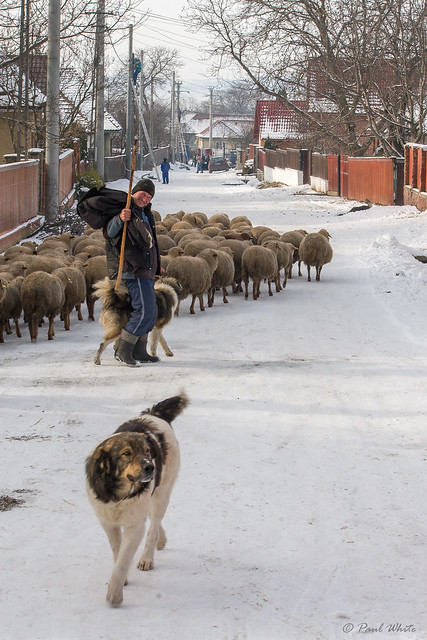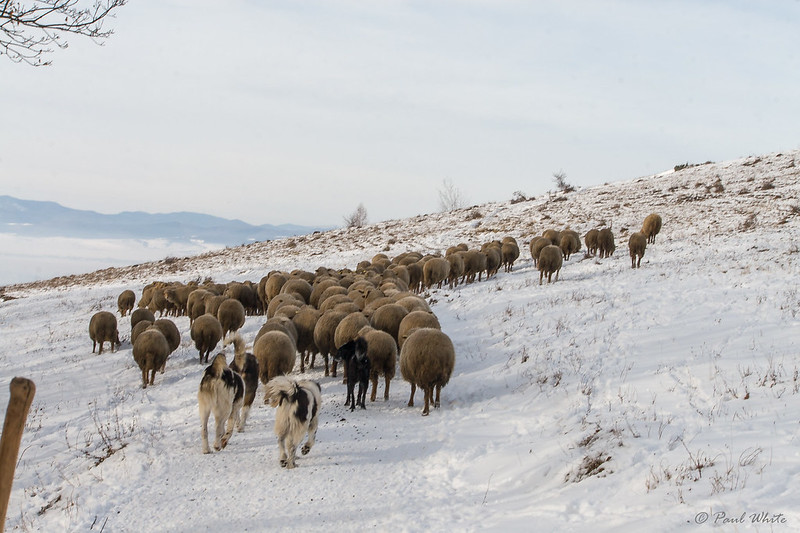by Paul White
Never let anyone tell you that it's not possible to farm with sheep in predator country because it is. Shepherds and herdsmen have been grazing livestock in Transylvania for centuries and without fences. The big difference here is that sheep never graze on open ground alone. Shepherds are always present with the support of their livestock guardian dogs (LGD) to instantly counter threats from predators.

This was far from a typical day as normally I would be down there in one of those snow covered houses trying to keep warm. It was well below freezing, but rather than sit around the house I decided to take a trip into the foothills with Bandi, one of the many shepherds that live in the village. Usually I visit Bandi in fair weather during the grazing season which covers spring, summer and autumn. So this winter grazing trip was a first for me.

This is not 'one man and his dog', but more one man and his pack! Bandi had chosen five dogs for the several hours of grazing planned in the surrounding hills. Several points have to be considered before deciding which and how many dogs to take.
Predator burden - This area of the eastern Carpathians has a high predator burden for shepherds. The greatest threat comes from wolves and bears, so more LGDs are required to protect sheep. In winter when food is scarce, wolves move down from the surrounding hills and forests. They usually prey on wild boar and deer, but in winter often target stray dogs from villages. There is also the expectation that bears are hibernating in winter, but not all, especially if there is a food source available. Bears scavenge from bins and passing motorists, but equally both predator species will take sheep if not adequately protected.
Flock size - obviously the more sheep you have to watch and protect the more LGDs you need. All dogs are different and their skills, personalities, strengths and weaknesses must all be considered by the shepherd when choosing which dogs to take with him. Seniors obviously have more experience and knowledge but may not be as fit and agile as the juniors. The oldest dog with us was twelve years old, an incredible age for such a large dog. Although fit and healthy, it stuck close to the shepherd and the sheep. So did two other dogs whilst the remaining two acted as 'outriders' checking the ground surrounding the flock, especially bushes and trees that offer cover for predators.
It is important to say that here there is never a scenario of a shepherd working with one dog. A single dog is no match for a wolf or bear. Dogs are only effective when working in cooperation with others, so two is always the minimum number.

Livestock guardian dogs do not drive sheep, they integrate with them and surround the flock to protect them. If a bear or wolf attacks then these dogs will put their lives on the line to repel the predator.
As soon as the dogs and sheep left the village they all knew the routine and made their way uphill along a track which connects with one of several communal meadows that surround the village. I followed taking photos and noted that there was little verbal communication between the shepherd and his dogs. There was no need really as the dogs knew what to do and the sheep knew where to go.

Obviously there's not the same amount of grass available compared to summer but the sheep did find some morsels to eat amongst the snow. However, these winter excursions are not just about nutrition as the sheep are given plenty of winter feed in large barns. This is also about exercising the animals, especially the dogs as the winter here can be very long, often extending from November to April.
Never let anyone tell you that it's not possible to farm with sheep in predator country because it is. Shepherds and herdsmen have been grazing livestock in Transylvania for centuries and without fences. The big difference here is that sheep never graze on open ground alone. Shepherds are always present with the support of their livestock guardian dogs (LGD) to instantly counter threats from predators.

This was far from a typical day as normally I would be down there in one of those snow covered houses trying to keep warm. It was well below freezing, but rather than sit around the house I decided to take a trip into the foothills with Bandi, one of the many shepherds that live in the village. Usually I visit Bandi in fair weather during the grazing season which covers spring, summer and autumn. So this winter grazing trip was a first for me.

This is not 'one man and his dog', but more one man and his pack! Bandi had chosen five dogs for the several hours of grazing planned in the surrounding hills. Several points have to be considered before deciding which and how many dogs to take.
Predator burden - This area of the eastern Carpathians has a high predator burden for shepherds. The greatest threat comes from wolves and bears, so more LGDs are required to protect sheep. In winter when food is scarce, wolves move down from the surrounding hills and forests. They usually prey on wild boar and deer, but in winter often target stray dogs from villages. There is also the expectation that bears are hibernating in winter, but not all, especially if there is a food source available. Bears scavenge from bins and passing motorists, but equally both predator species will take sheep if not adequately protected.
Flock size - obviously the more sheep you have to watch and protect the more LGDs you need. All dogs are different and their skills, personalities, strengths and weaknesses must all be considered by the shepherd when choosing which dogs to take with him. Seniors obviously have more experience and knowledge but may not be as fit and agile as the juniors. The oldest dog with us was twelve years old, an incredible age for such a large dog. Although fit and healthy, it stuck close to the shepherd and the sheep. So did two other dogs whilst the remaining two acted as 'outriders' checking the ground surrounding the flock, especially bushes and trees that offer cover for predators.
It is important to say that here there is never a scenario of a shepherd working with one dog. A single dog is no match for a wolf or bear. Dogs are only effective when working in cooperation with others, so two is always the minimum number.

Livestock guardian dogs do not drive sheep, they integrate with them and surround the flock to protect them. If a bear or wolf attacks then these dogs will put their lives on the line to repel the predator.
As soon as the dogs and sheep left the village they all knew the routine and made their way uphill along a track which connects with one of several communal meadows that surround the village. I followed taking photos and noted that there was little verbal communication between the shepherd and his dogs. There was no need really as the dogs knew what to do and the sheep knew where to go.

Obviously there's not the same amount of grass available compared to summer but the sheep did find some morsels to eat amongst the snow. However, these winter excursions are not just about nutrition as the sheep are given plenty of winter feed in large barns. This is also about exercising the animals, especially the dogs as the winter here can be very long, often extending from November to April.